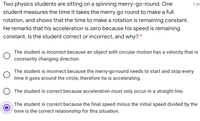Question
I accidentally selected an answer just ignore it

Transcribed Image Text:Two physics students are sitting on a spinning merry-go-round. One
1 po
student measures the time it takes the merry go round to make a full
rotation, and shows that the time to make a rotation is remaining constant.
He remarks that his acceleration is zero because his speed is remaining
constant. Is the student correct or incorrect, and why? *
The student is incorrect because an object with circular motion has a velocity that is
constantly changing direction.
The student is incorrect because the merry-go-round needs to start and stop every
time it goes around the circle, therefore he is accelerating.
The student is correct because acceleration must only occur in a straight line.
The student is correct because the final speed minus the initial speed divided by the
time is the correct relationship for this situation.
Expert Solution
This question has been solved!
Explore an expertly crafted, step-by-step solution for a thorough understanding of key concepts.
Step by stepSolved in 2 steps

Knowledge Booster
Similar questions
arrow_back_ios
arrow_forward_ios